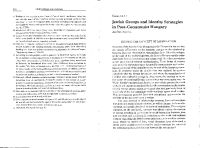Jewish Groups and Identity Strategies in Post-Communist Hungary
Author(s)
Publication Name
Publication Date
Publisher
Abstract
Under democracy in Hungary, Jews developed new identity strategies, but their choices of strategy were clearly dependent on earlier identities and the extent to which they had moved away from traditional Jewishness.
Today in Hungary, one end of the spectrum is filled by groups that continue to observe strictly Jewish religious traditions. At the other end of the spectrum, there are those for whom Jewish background is at most a fact of origin stored in the backroom of family memory and possessing no
public significance and little personal relevance. The majority Of Jews living in the country are to be found somewhere between the two extremes. The content of their identity may be the preservation of tradition at some level or other, or it may be a secular or ethnic-national consciousness of identity, or it may even be the preserving of the memory of forebears, ties With Jewish culture, or the feeling of being at home and of protection in a Jewish environment within Hungarian
society.
Jews who preserve traditions are clearly following the strategy of acceptance, while those at the other end of the spectrum have chosen the strategy of rejection, Between the two extremes, both strategies are present, and positions are dynamic: in this group it is possible to observe strategies providing a release from the stigma of the Jews as well as strategies providing a rescue from the stigma. Often these strategies are employed alternately by successive generations.
Today in Hungary, one end of the spectrum is filled by groups that continue to observe strictly Jewish religious traditions. At the other end of the spectrum, there are those for whom Jewish background is at most a fact of origin stored in the backroom of family memory and possessing no
public significance and little personal relevance. The majority Of Jews living in the country are to be found somewhere between the two extremes. The content of their identity may be the preservation of tradition at some level or other, or it may be a secular or ethnic-national consciousness of identity, or it may even be the preserving of the memory of forebears, ties With Jewish culture, or the feeling of being at home and of protection in a Jewish environment within Hungarian
society.
Jews who preserve traditions are clearly following the strategy of acceptance, while those at the other end of the spectrum have chosen the strategy of rejection, Between the two extremes, both strategies are present, and positions are dynamic: in this group it is possible to observe strategies providing a release from the stigma of the Jews as well as strategies providing a rescue from the stigma. Often these strategies are employed alternately by successive generations.
Topics
Editor
Genre
Geographic Coverage
Copyright Info
All rights reserved
Original Language
Page Number / Article Number
211-242
ISBN/ISSN
9639241628
Related
Bibliographic Information
Jewish Groups and Identity Strategies in Post-Communist Hungary. . 2003: 211-242. https://archive.jpr.org.uk/object-hun11




